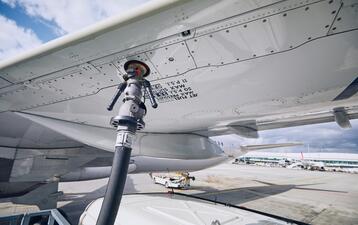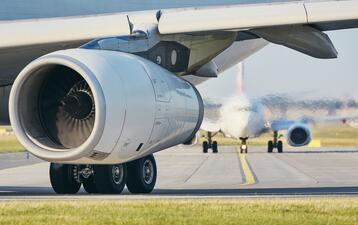Flood Risk Modelling for Airports to Build Climate Resilience
Title Image Description: Visualisation of flooded areas (blue shades) close to a runway with different rainfall intensities
Airports are among the most complex infrastructures to design, operate, and safeguard—particularly under intensifying climate variability. Climate change is already posing significant challenges for airports, with an uncertain outlook for the future. Depending on their geographical and climatic location, airports are expected to experience higher average temperatures, more frequent heat waves, an increase in heavy rainfall and storms, and a corresponding rise in the risk of extreme weather events. These climate change-related effects have negative impacts on aircraft and airport operations, airport infrastructure and equipment, passengers, airport staff and personnel. Effective rainwater management is no longer a supplementary task but a critical operational pillar for ensuring resilience, safety, and regulatory compliance. As impervious surfaces expand, infrastructure continues to age, and environmental regulations grow stricter, planning and implementing stormwater systems at airports requires a careful balance of technical accuracy and innovation.
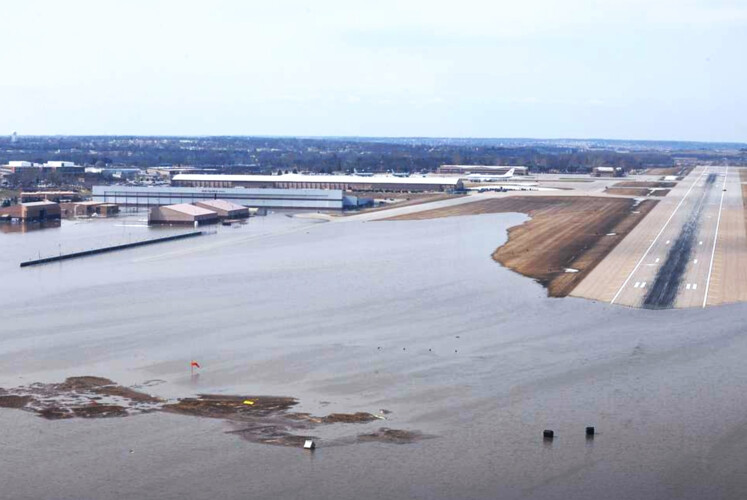
Image Description: Severe flooding at Norwood Memorial Airport (KOWD), 2010
Recent incidents such as flooding of apron areas in Palma di Mallorca and Dubai Intl., runway meltdowns and concrete blow-ups in Luton (LTN) and Hanover (HAJ) due to extreme heat, or sudden heavy snowfall in Vancouver (YVR) highlight the vulnerability of airports to extreme weather events. Airports and other aviation stakeholders must therefore adapt their personnel, infrastructure, and operational processes to these weather events as best as possible. Under EU Directive 2557/2024 (resilience of critical entities, EU RCE Directive), airports are also required to conduct climate risk assessments and develop resilience measures to protect against physical hazards resulting from natural disasters and climate change.
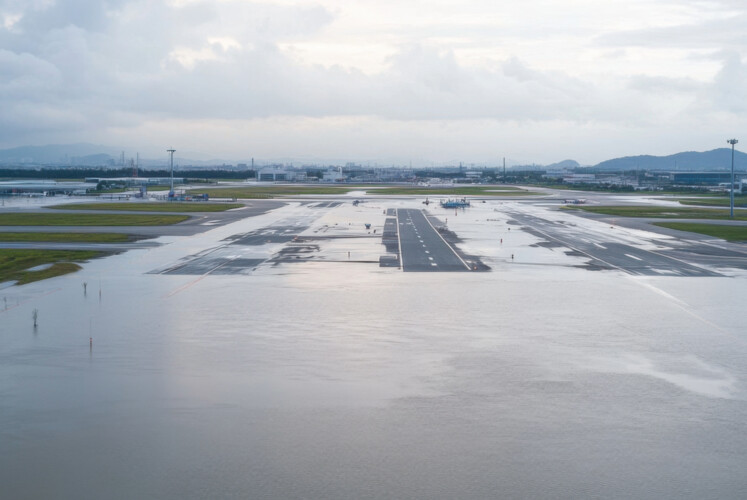
Image Description: Hopefully just fiction: AI-generated image of flooded areas at an airport
In close cooperation with IPS – The Stormwater Experts, airsight conducts detailed flood risk assessments as part of climate risk assessments and works with customers to develop appropriate adaptation measures, in particular the upgrading of the necessary stormwater drainage infrastructure at the airport and the implementation of business continuity and contingency strategies at the airport operational and process level. In the past, the project team has carried out flood risk assessments for airports in Europe and Southeast Asia against the backdrop of increasing heavy rainfall events and sea level rise, and develop recommendations for upgrading the infrastructure. New infrastructure such as terminals, flight operation areas, or PV systems may also require flood risk and soil erosion assessments and continuous adaptation of infrastructure and procedures. Typical work steps within an airport flood risk assessment include:
1. Strategic Drainage Planning
- Site-specific drainage concepts for complex airport environments
- Phased planning aligned with airport expansion or redevelopment timelines
- Assessment of existing infrastructure for reuse and integration
2. Advanced Hydrological and Hydraulic Modeling
- 1D/2D simulations of stormwater runoff, ponding, and surface flow
- Coupled sewer-surface modeling for realistic scenario testing
- Climate-resilient design through predictive rainfall and flood simulations
3. Blue-Green Infrastructure Integration
- Design of tree trenches, intelligent retention spaces and wetlands
- Green roofs and infiltration systems for runoff retention and evapotranspiration
- Use of multifunctional open spaces to combine stormwater storage with recreational and ecological value
4. Climate Adaptation & Risk Management
- Status-quo evaluation
- Heavy rain and flood hazard analyses
- Scenario development for future climate conditions
- Sponge city principles and water balance simulation
5. Erosion and Soil Risk Assessment
- MUSLE-based modeling of erosion-prone areas
- Development of mitigation strategies (e.g., turfing, vegetation buffers)
- Integration of soil stability into infrastructure layout decisions
- Identification of critical erosion hotspots under extreme weather scenarios
6. Aeronautical implications
- Adaptation of airport infrastructure based on results from flood risk assessment
- Conduction of Aviation Safety Risk Assessments
- Optimization of airport operational processes and procedures
- Engagement and coordination with airport stakeholders
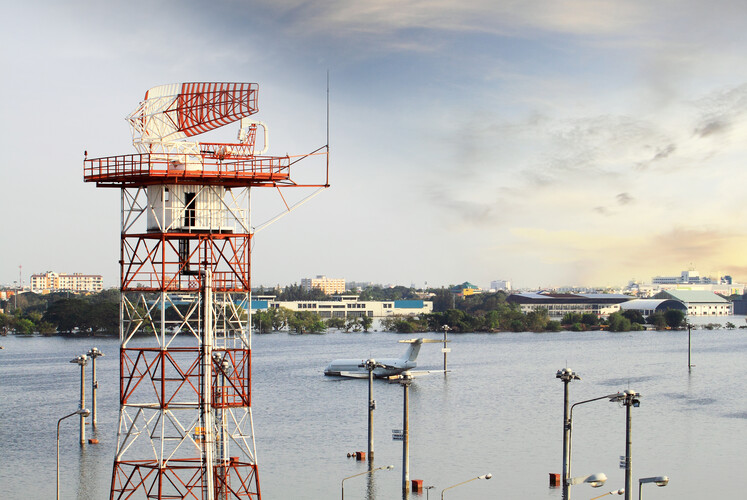
Image Description: Severe flooded apron areas at Don Mueang Intl. Airport (VTBD), formerly BKK; now DMK, 2011
Is your airport affected by the effects of climate change? Have operational restrictions already been observed and has damage to infrastructure occurred? Do you need worst-case flooding scenarios and want to build up additional drainage systems to be prepared for heavy rainfall events in the future? Together with our cooperation partner Sieker, airsight offers detailed analyses in the field of climate risk assessments and flood risk modeling for airports. Contact us for my information on our consulting portfolio!
The engineering company Prof. Dr. Sieker offers services and products related to civil engineering, environmental engineering, geography, water management and hydroinformatics. This diverse knowledge base enables IPS to develop comprehensive solutions and innovative concepts in the fields of rainwater management and water resources engineering.
Sieker has a proven track record of successfully completed hydraulic computation and flood risk assessment at airports (e.g. Berlin-Tegel airport and a major hub-airport in south-east Asia) as well as other off-airport project clients in Europe and Asia (e.g. South Korea and Saudi Arabia).
Key Facts



